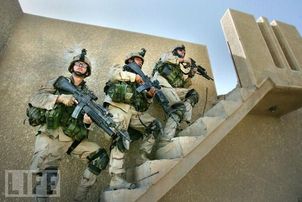The Iraq War
Assault on Fallujah
November 8, 2004
On November 8, 2004 over 15,000 marines and 2,000 Iraqis soldiers invaded the town of Fallujah. Previously, in April of 2004 Coalition Forces had invaded Fallujah to kill insurgents and take over the city. On April 28, 2004, after the conclusion of Marine launched Operation Vigilant Resolve, an agreement is met that states local citizens would keep insurgents out of the town. At that same time, a U.S. official was said to have stated that catching Abu Musab Al-Zarqawi, a prominent Iraqi figure, was of the utmost priority. It was said that Abu Musab Al-Zarqawi resided in Fallujah. The Fallujah Brigade is set up combining Iraqi forces and U.S. forces to take over the city once more. It wasn’t until November 7th of the same year that forces prepared to invade the town. A day later on November 8th Operation Phantom Fury, the invasion of Fallujah began. The three month battle that resulted became known as the bloodiest battle of the Iraq War. It was said that around 36,000 of the roughly 50,000 homes in Iraq were destroyed, along with about 60 school an 65 shrines. Though there is some discrepancies over the numbers, it is said that between 4000 and 6000 Iraqis died during the battle. Of the Iraqis killed only about 1350 were insurgents. This was also a tragic battle for the U.S., British, and Iraqi coalition force. In total about 95, 11 Iraqis and three British troops were killed. The end result of the battle was not as successful as U.S. officials had hoped. While the invasion of the town did kill thousands of insurgents and destroyed a key foothold of al-Qaeda in Iraq, they never managed to capture Abu Musab Al-Zarqawi. When the coalition forces began leaving the city following the end of the battle, insurgents also began rebuilding a power in the city. Though insurgents were mostly wiped out in the invasion, the months following the invasion lead to a steady increase in insurgent power over the city. More then half a year later, on 23 June 2005, a suicide bombing from insurgents killed six marines and injured many more. However a third and relatively successful battle of Fallujah finally turned over to Iraqi forces. Another problem soon arose following the battle. It was documented that white phosphorus, WP, was used by U.S. forces that resulted in insurgent and civilian deaths. It was said that the characteristics of WP is very noticeable as someone killed by it would partially turn into ash with skin peeling off then hands. In 1993 Chemical Weapons Convention prohibited the use of white phosphorus on personnel. Also, according to the Organisation for the Prohibition of Chemical Weapons, white phosphorus can be used as an illumination device but not as an offensive weapon. While the U.S. denies that is used WP weapons on civilians, it admits to using the bombs as offensive weapons on insurgents. Though in the end, this controversy received little attention even after an article was posted in the Washington Post. The second invasion of Fallujah was notably the most bloody and horrid battle of the Iraq War. Deaths stacked insurmountably high for both sides with thousands of innocent civilians destroyed. The result of the battle was considered helpful to the coalition forces limiting the power of al-Qaeda. American forces, along with the help of Iraqis and British forces were able to kill many insurgents and destroy one of the key strongholds of al-Qaeda.


